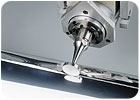
A number of solar panel manufacturers in North America, Europe and Asia have begun using ultrasonic welding to splice the thin aluminum foils in their products.
To help overcome these challenges, a number of manufacturers have begun using the MS5010B ultrasonic foil splicer from Sonobond Ultrasonics (West Chester, PA) to weld the aluminum interconnects between the photovoltaic cells. By creating reliable, solid-state mechanical bonds between the panels, the new system allows manufacturers to boost their products’ voltage and current.
Manufacturers currently using the foil splicer include Bangkok Solar (Bangkok, Thailand), Energy Photovoltaics Inc. (Princeton, NJ), EnerGoSolar (Budapest, Hungary) and Kraft Electronics Inc. (Budapest, Hungary). These companies have chosen ultrasonic welding, because it offers a number of benefits over other methods of bonding. For example, the bonds have essentially the same strength and structure as their base materials, and the process doesn’t require excessive heat, fluxes, filler metals, tapes or other consumables. In addition, the foil splicer employs an extra-high vibration frequency to avoid cracking the glass panels in the photovoltaic cells.
In operation, the system can create consistent splices in foils between 0.00017- and 0.006-inch thick. Each system includes a power unit with a solid-state frequency converter, a welding head and a rotating disk tip that traverses the weld area at speeds as high as 15 fpm, depending on thickness and type of alloy. The system can be easily fitted to most foil-separating and splicing machinery. Because the welded seams retain the metallurgical and dimensional characteristics of their base metal, they can be safely subjected to further processing, such as rerolling, laminating or printing.
More more information on ultrasonic welding, call 800-323-1269 or visitwww.sonobondultrasonics.com.